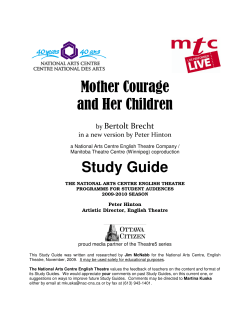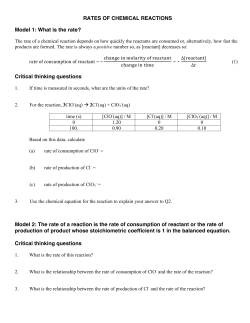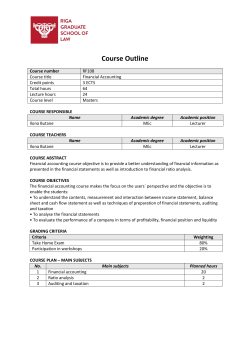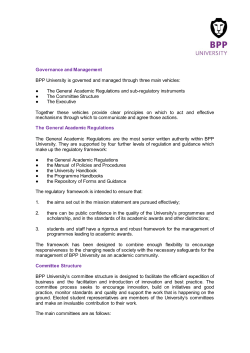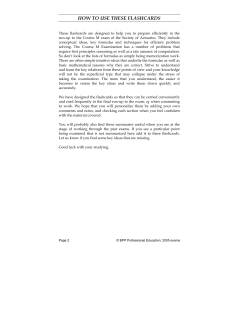
CHM 112 Worksheet Chapter 12
CHM 112 Chapter 13 Worksheet: Chemical Kinetics Name:____________________ Q1. The reaction 2NO2 (g) → 2NO (g) + O2(g) was studied at 383 °C and the following data was obtained. Time (s) 0.0 5.0 10.0 15.0 20.0 [NO2 ](M) 0.100 0.017 0.0090 0.0062 0.0047 Plot this data and determine if the reaction is first or second order. From the slope of the trendline, find the rate constant. (Attach the graphs) Q2. For the reaction 2 A + B → 3 C, it was found that the rate of disappearance of B was 0.30 Ms-1 . What is the rate of disappearance of A and the rate of appearance of C. Q3. The decomposition of N2O5 has activation energy of 103 kJ/mol and a frequency factor of 4.3 x 1013 s-1. What is the rate constant for this decomposition at 298 K? Q4. For a particular first order reaction, it takes 75.0 min for the concentration of the reactant to drop to 25% of its initial value. What is the rate constant for this reaction? Q5. Suppose a reaction occurs with the following mechanism. Step 1 Step 2 2 A ↔ A2 A2 + E (g) → B + C (A) What is the overall reaction? (B) What are the intermediates in the mechanism? (C) What is the molecularity of each step? (D) Which is the rate determining step? (E) What is the rate law predicted by this mechanism? fast, equilibrium slow Q6. The following data were collected for the reaction 2 NO (g) + O2(g) 2 NO2 (g) Run 1 2 3 Initial [NO] 0.0010 M 0.0010 M 0.0062M Initial [O2] 0.0010 M 0.0037 M 0.0037 M Rate in M/s 7.10 26.3 1011 (A) What is the rate law for the reaction? (B) Calculate the value of the rate constant k. Q7. For each of the following reactions, write down the rate of the reaction in terms of the appearance of products and disappearance of reactants a) 2 N2O5(g) 4 NO2(g) + O2(g) b) CH3Cl (g) + 3 Cl2(g) →CCl4 (g) + 3 HCl (g) c) 4 PH3 (g) → P4 (g) + 6 H2 (g) Q8. The decomposition of NOCl has k= 9.3 x 10-5 M-1s-1 at 100. ºC and k= 1.0 x 10-3 M-1 s-1 at 130 ºC. Calculate the value for the activation energy for the decomposition of NOCl. Q9. The decay of radioactive Rn-220 to Po-216 has a half life of 55.6 seconds. If one starts with a 1.00 mg sample of Rn-220, how much is left after 10.0 minutes? Q10. Consider the reaction 2 NO (g) + 2 H2(g) N2(g) + 2 H2O (g). The reaction is found to be first order in H2 and second order in NO. a) Write down the rate law for this reaction. b) What will be the rate of the reaction when [NO] = 0.025 M and [H2] = 0.015 M, given that the rate constant is 6.0 104 M-2 s-1 c) Calculate the rate when the concentration of NO is increased to 0.10 M and while the concentration of H2 is 0.010 M Q11. The decomposition of NOBr follows second order kinetics. The rate constant is found to be 0.556 M-1 s-1. If the initial concentration of NOBr in the container is 0.25 M, how long will it take for the concentration to decrease to 0.025 M? What is the half life of the decomposition when the initial reactant concentration is 0.25 M? Q12. A first order reaction has a half life of 245 minutes at 600. K. What is the value for the rate constant for this reaction? How much time will it take for the concentration to drop to one tenth of its initial value? Q13. A certain first-order reaction has a rate constant of 2.75 10-2 s-1 at 20. ºC. Calculate the value of the rate constant at 60. ºC if Ea = 75.5 kJ/mol. Q14. A possible mechanism for the overall reaction Br2(g) + NO (g) → 2 NOBr (g) is k1 Step 1: NO (g) + Br2 (g) NO Br2 (g) (fast) k-1 k2 Step 2: NO Br2 (g) + NO (g) → 2NOBr (slow) The reaction is experimentally determined to be second order in NO and first order in Br2 a) Write down the experimentally determined rate law. b) Is the mechanism consistent with the observed rate law?
© Copyright 2025
